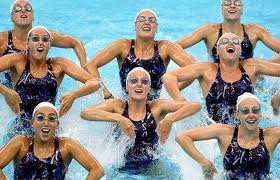Synchronized Swimming is a women's only sport at the Olympic level. Swimming is a technique used to move through water using only movements of the body. Swimming is a method for survival in water. Synchronized swimmers are incredible athletes. They hold their breath for long periods of time while performing intricate, coordinated dance movements in the swimming pool. Synchronized Swimming is a woman’s only sport at the Olympic level, was an exhibition sport at the Olympic Games from 1948 to 1968, then became a full-fledged Summer Olympic sport in 1984. At the 1984, 1988, and 1992 games there were solo and duet events. In 1996, only a team event was held. Since 2000, a team event and a duet event have been held. The new swimming marathon 10 kilometer events has been held in 2008 Olympic.
In Synchronized Swimming technical routine requires the swimmers to perform specific movements in a specific order. The Olympic medals are awarded based on total points earned by the swimmers. Two 5-judge panels watch the routines and award points on a scale of 0-10. One panel scores technical merit and the other scores artistic impression. All of the judges are watching the difficulty for each movement, how well the routine is executed and synchronized, and how easy the swimmers make it look. The highest score wins gold, second wins silver, and third win bronze. There could be ties in scoring, in which case both earn that medal.
Sport Ticket Exchange is guaranteed, fast and secure source to buy Sport Tickets especially Olympic Tickets. Olympic fans that have spare tickets and want to earn profit can Sell Olympic Tickets at Sport Ticket Exchange.
Olympic Synchronised Swimming
Sport Ticket Exchange































